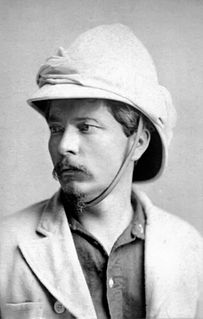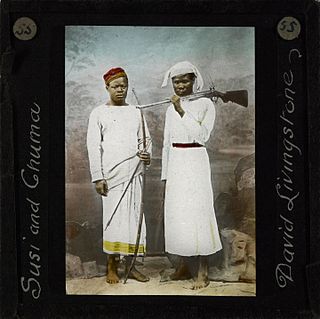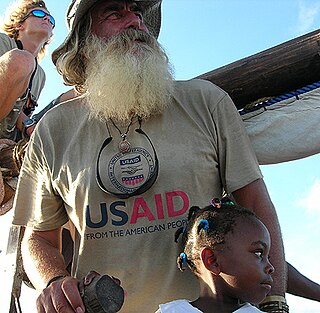
The Congo River, formerly also known as the Zaire River, is the second longest river in Africa, shorter only than the Nile, as well as the second largest river in the world by discharge volume, following only the Amazon. It is also the world's deepest recorded river, with measured depths in excess of 220 m (720 ft). The Congo-Lualaba-Chambeshi River system has an overall length of 4,700 km (2,920 mi), which makes it the world's ninth-longest river. The Chambeshi is a tributary of the Lualaba River, and Lualaba is the name of the Congo River upstream of Boyoma Falls, extending for 1,800 km (1,120 mi).

Sir Henry Morton Stanley was a Welsh-American explorer, journalist, soldier, colonial administrator, author and politician who was famous for his exploration of Central Africa and his search for missionary and explorer David Livingstone, whom he later claimed to have greeted with the now-famous line: "Dr. Livingstone, I presume?". Besides his discovery of Livingstone, he is mainly known for his search for the sources of the Nile and Congo rivers, the work he undertook as an agent of King Leopold II of the Belgians which enabled the occupation of the Congo Basin region, and his command of the Emin Pasha Relief Expedition. He was knighted in 1897, and served in Parliament as a Liberal Unionist member for Lambeth North from 1895 to 1900.

David Livingstone was a Scottish physician, Congregationalist, and pioneer Christian missionary with the London Missionary Society, an explorer in Africa, and one of the most popular British heroes of the late 19th-century Victorian era. He had a mythic status that operated on a number of interconnected levels: Protestant missionary martyr, working-class "rags-to-riches" inspirational story, scientific investigator and explorer, imperial reformer, anti-slavery crusader, and advocate of British commercial and colonial expansion.

Captain John Hanning Speke was an English explorer and officer in the British Indian Army who made three exploratory expeditions to Africa. He is most associated with the search for the source of the Nile and is wrongly said to be the first European to reach Lake Victoria when in fact the first European to find them in the 17th century was the Spanish, Jesuit and missionary Pedro Paez, as stated in his book History of Ethiopia, 200 years before the birth of Hanning.
Colonization of the Congo basin refers to the European colonization of the Congo Basin of tropical Africa. It was the last part of the continent to be colonized. By the end of the 19th century, the Basin had been carved up by European colonial powers, into the Congo Free State, the French Congo and the Portuguese Congo.

The geography of North Africa has been reasonably well known among Europeans since classical antiquity in Greco-Roman geography. Northwest Africa was known as either Libya or Africa, while Egypt was considered part of Asia.
Benedict Colin Allen FRGS is an English writer, explorer, traveller and filmmaker known for his technique of immersion among indigenous peoples from whom he acquires survival skills for hazardous journeys through unfamiliar terrain. In 2010, Allen was elected a Trustee and Member of Council of the Royal Geographical Society.

Kevin Sites is an American author and freelance journalist. He has spent nearly a decade covering global wars and disasters for ABC, NBC, CNN, and Yahoo! News. Dubbed by the trade press as the "granddaddy" of backpack journalists, Sites helped blaze the trail for intrepid reporters who work alone, carrying only a backpack of portable digital technology to shoot, write, edit, and transmit multimedia reports from the world's most dangerous places. His first book, In the Hot Zone: One Man, One Year, Twenty Wars, shares his effort to put a human face on global conflict by reporting from every major war zone in one year.

Thomas Heazle Parke (1857–1893) was an Irish physician, British Army officer and author who was known for his work as a doctor on the Emin Pasha Relief Expedition.

John Julian Timothy Jeal, known as Tim Jeal, is a British biographer of notable Victorians and is also a novelist. His publications include a memoir and biographies of David Livingstone (1973), Lord Baden-Powell (1989), and Sir Henry Morton Stanley (2007).
Il était une fois... les Explorateurs is a French animated TV series from 1997. It was directed by Albert Barillé. It is part of the Once Upon a Time... franchise.

James Chuma and Abdullah Susi were people from central Africa who took part in the second Zambesi expedition led by the explorer David Livingstone, and were employed by him in his last expedition. They had significant roles in organisation, and were the first to greet Stanley when his search party made contact.

Between 1874 and 1877 Henry Morton Stanley traveled central Africa East to West, exploring Lake Victoria, Lake Tanganyika and the Lualaba and Congo rivers. He covered 7,000 miles (11,000 km) from Zanzibar in the east to Boma in the mouth of the Congo in the west and resolved a number of open questions concerning the geography of central Africa. This including identifying the source of the Nile, which he proved was not the Lualaba – which is in fact the source of the river Congo.

Kingsley Holgate is a South African explorer, humanitarian and author. A fellow of the Royal Geographical Society, he has been described by Getaway Magazine as "the most travelled man in Africa" and has modelled himself on David Livingstone. Holgate has also written several books about his expeditions and fronted several National Geographic documentaries.
David Livingstone is a 1936 British historical adventure film directed by James A. FitzPatrick and starring Percy Marmont, Marian Spencer and James Carew. It portrays the expedition of the British explorer David Livingstone to Africa to discover the source of the Nile, his disappearance, and the expedition to find him led by Stanley. The film was made at Shepperton Studios for distribution by MGM.
Major explorations of Earth continued after the Age of Discovery. By the early seventeenth century, vessels were sufficiently well built and their navigators competent enough to travel to virtually anywhere on the planet by sea. In the 17th century Dutch explorers such as Willem Jansz and Abel Tasman explored the coasts of Australia. Spanish expeditions from Peru explored the South Pacific and discovered archipelagos such as Vanuatu and the Pitcairn Islands. Luis Vaez de Torres chartered the coasts of New Guinea and the Solomon Islands, and discovered the strait that bears his name. European naval exploration mapped the western and northern coasts of Australia, but the east coast had to wait for over a century. Eighteenth-century British explorer James Cook mapped much of Polynesia and traveled as far north as Alaska and as far south as the Antarctic Circle. In the later 18th century the Pacific became a focus of renewed interest, with Spanish expeditions, followed by Northern European ones, reaching the coasts of northern British Columbia and Alaska.
Mireya Mayor is an American anthropologist and wildlife correspondent for the National Geographic. On one of her expeditions in Madagascar, she discovered a new species of lemur, considered the world’s smallest primate. She has co-written several scientific papers on lemurs species. She has been referred to as the "female Indiana Jones." Her work has provided her with extensive field experience studying primates, tarantulas, and other wild animals.
Roy C Bridges was a noted historian the main focus of whose academic work was the British institutions and personnel which were established in East Africa in the middle years of the nineteenth century. He was Professor of History at the University of Aberdeen where he taught from 1964 to 1997. Between 2002 to 2008 he was the President of the Hakluyt Society. He was also a Fellow of the Royal Geographical Society and the Royal Historical Society.
"What About Livingstone?" is a song by ABBA, released on their 1974 album Waterloo.
Major Levison James Wood is a British Army officer and explorer. He is best known for his extended walking expeditions in Africa, Asia and Central America. He has also undertaken numerous other overland journeys, including a foot crossing of Madagascar and mountain climbing in Iraq. He documents his journeys through books, documentaries and photography.










